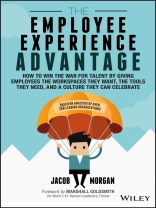Research Shows Organizations That Focus on Employee Experience Far Outperform Those That Don’t
Recently a new type of organization has emerged, one that focuses on employee experiences as a way to drive innovation, increase customer satisfaction, find and hire the best people, make work more engaging, and improve overall performance. The Employee Experience Advantage is the first book of its kind to tackle this emerging topic that is becoming the #1 priority for business leaders around the world. Although everyone talks about employee experience nobody has really been able to explain concretely what it is and how to go about designing for it…until now.
How can organizations truly create a place where employees want to show up to work versus need to show up to work? For decades the business world has focused on measuring employee engagement meanwhile global engagement scores remain at an all time low despite all the surveys and institutes that been springing up tackle this problem. Clearly something is not working. Employee engagement has become the short-term adrenaline shot that organizations turn to when they need to increase their engagement scores. Instead, we have to focus on designing employee experiences which is the long term organizational design that leads to engaged employees. This is the only long-term solution. Organizations have been stuck focusing on the cause instead of the effect. The cause is employee experience; the effect is an engaged workforce.
Backed by an extensive research project that looked at over 150 studies and articles, featured extensive interviews with over 150 executives, and analyzed over 250 global organizations, this book clearly breaks down the three environments that make up every single employee experience at every organization around the world and how to design for them. These are the cultural, technological, and physical environments. This book explores the attributes that organizations need to focus on in each one of these environments to create COOL spaces, ACE technology, and a CELEBRATED culture. Featuring exclusive case studies, unique frameworks, and never before seen research, The Employee Experience Advantage guides readers on a journey of creating a place where people actually want to show up to work.
Readers will learn:
- The trends shaping employee experience
- How to evaluate their own employee experience using the Employee Experience Score
- What the world’s leading organizations are doing around employee experience
- How to design for technology, culture, and physical spaces
- The role people analytics place in employee experience
- Frameworks for how to actually create employee experiences
- The role of the gig economy
- The future of employee experience
- Nine types of organizations that focus on employee experience
- And much more!
There is no question that engaged employees perform better, aspire higher, and achieve more, but you can’t create employee engagement without designing employee experiences first. It’s time to rethink your strategy and implement a real-world framework that focuses on how to create an organization where people want to show up to work. The Employee Experience Advantage shows you how to do just that.
Содержание
Foreword xiii
Acknowledgments xvii
We All Care about Experience (Introduction) xix
Part I The Evolution of Employee Experience 1
1 Defining Employee Experience 3
Utility 3
Productivity 3
Engagement 5
Employee Experience 6
2 Research on Employee Experience 11
A Note about the Research Sponsors 15
3 Employee Experience Drivers 17
Poor Success with Engagement 18
Engagement Measures Downward 18
Engagement Has Become the New Annual Review 20
Engagement Tends to Look at the Effect but Not the Cause 21
Engagement Surveys Are Exhaustingly Long 22
Engagement Acts as an Adrenaline Shot 22
The War for Talent 26
Skills Gap and Talent Shortage 26
Changing Demographics 27
Changing Face of Talent Competition 28
Psychology (and Sociology) 29
Business Turbulence 29
Technology 30
Alternative Work Arrangements and the Gig Economy 32
Growing Fast but Not Dominating 33
The Effect on Employee Tenure 35
People Analytics 38
People Analytics in Action 40
The Future of People Analytics 43
Transparency 45
Part II The Reason for Being and the Three Employee Experience Environments 49
4 Reason for Being 51
Statements from Leading Organizations 52
The Three Employee Experience Environments 56
5 The Physical Environment 59
Chooses to Bring in Friends or Visitors 61
Offers Flexibility 64
Organization’s Values Are Reflected 67
Leverage Multiple Workspace Options 70
How Organizations Scored 74
6 The Technological Environment 77
Availability to Everyone 78
Consumer Grade Technology 82
Employee Needs versus Business Requirements 84
How Organizations Scored 86
7 The Cultural Environment 89
Company Is Viewed Positively 90
Everyone Feels Valued 95
Compensation and Benefits 96
Having Employee’s Voices Heard 97
Organization Doesn’t Ask 97
Organization Asks but Does Nothing 98
Organization Asks and Acknowledges 98
Organization Asks, Acknowledges, and Acts 98
Employees Are Recognized for the Work That They Do 98
Legitimate Sense of Purpose 100
Employees Feel like They’re Part of a Team 107
Believes in Diversity and Inclusion 109
Referrals Come from Employees 112
Ability to Learn New Things and Given the Resources to Do So and Advance 114
Learning and Development 115
Advancement 118
Treats Employees Fairly 120
Executives and Managers Are Coaches and Mentors 122
Dedicated to Employee Health and Wellness 124
How Organizations Scored 126
8 The Employee Experience Equation 131
Part III Why Invest in Employee Experience? 133
9 The Nine Types of Organizations 135
in Experienced 136
Emerging 137
Engaged 139
Empowered 140
Enabled 140
pre Experiential 141
Experiential 141
10 Employee Experience Distribution 145
11 The Business Value of Employee Experience 149
Customer Service 151
Innovation 153
Employer Attractiveness 153
Admiration and Respect 154
Brand Value 154
Other Lists 155
12 Business Metrics and Financial Performance 157
13 The Cost of Employee Experience 167
Part IV Building the Experiential Organization 171
14 System 1 versus System 2 Experiences 173
15 The Employee Experience Design Loop 177
Respond 178
Analyze 180
Scenario 1 Analysis Reveals 180
Scenario 1 Insight for Your Organization 180
Scenario 2 Analysis Reveals 181
Scenario 2 Insight for Your Organization 181
Scenario 3 Analysis Reveals 181
Scenario 3 Insight for Your Organization 181
Analysis Enablers 181
Design 182
Launch 183
Participate 183
Example: General Electric 184
Respond 184
Analyze 185
Design 185
Launch 186
Participate 187
Example: Airbnb 189
Respond 189
Analyze 189
Design 190
Launch 191
Participate 191
16 The Starbucks Model of Transparency 193
17 The Employee Life Cycle 197
18 Moments That Matter or Moments of Impact 201
Specific Moments That Matter 201
Ongoing Moments That Matter 202
Created Moments That Matter 203
Moments That Matter at Cisco 203
19 Moments That Matter and Employee Experience 205
20 The Employee Experience Pyramid 209
21 What about the Actual Work? 213
22 Who Owns the Employee Experience? 217
Initiated by the CEO and Executive Team 217
Owned by the People Team 219
Driven by Managers 220
Championed by Everyone 222
23 A Lesson from Airbnb 223
24 The Role of Employees 227
25 Where to Start 229
You Have to Care, Really Care 229
Define a Reason for Being 231
Build a People Analytics Function 232
Start Small 232
Identify the Required Skills 234
Have Executive Support, Typically the Chief People Officer 236
Train the Organization 236
Tell Stories 237
Build or Improve the Experience Team 237
Deploy Feedback Tools/Mechanisms 239
In-Person Feedback 239
Feedback via Technology 241
Implement COOL Spaces, ACE Technology, and CELEBRATED Culture 242
Example: Adobe 244
Technological Environment 244
Physical Environment 245
Cultural Environment 246
Identify and Create Moments That Matter (or Moments of Impact) 250
Think of Your Organization like a Lab Instead of a Factory 253
26 Focus on What Makes Your Company Unique 257
27 Size, Industry, and Location Don’t Matter 261
Always Improve 262
Think like a Laboratory 262
Move beyond Checklists 263
Put People at the Center and Know Them 264
Design with, Not For 264
Care 264
Focus on What Makes You Unique 265
28 A Futurist’s Perspective 267
Appendix 269
Index 271
Об авторе
JACOB MORGAN is a best-selling author, keynote speaker, futurist, and co-founder of The Future of Work Community, a brand council of the world’s leading organizations exploring how the workplace is changing. A highly sought after expert worldwide, he is regularly featured in media publications such as Forbes, Inc., The Wall Street Journal, and many others. He has a regular podcast show on i Tunes and a weekly show on Youtube where he shares inspiring and motivational videos on the future of work. He is the bestselling author of The Future of Work and The Collaborative Organization. Jacob lives in Alameda, California with his wife, daughter, and two dogs. To learn more about Jacob and get access to his content visit: The Future Organization.com or email him: Jacob@The Future Organization.com












